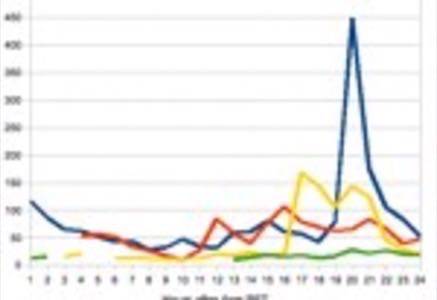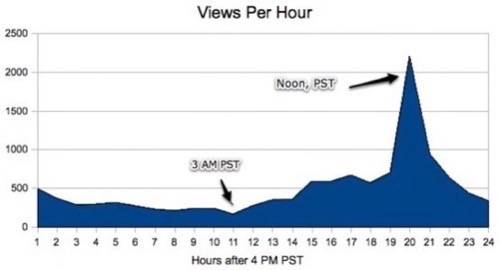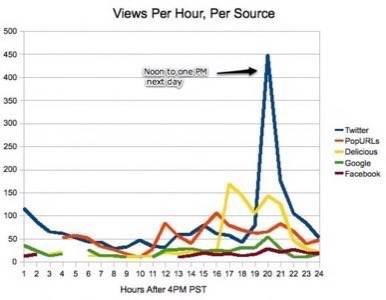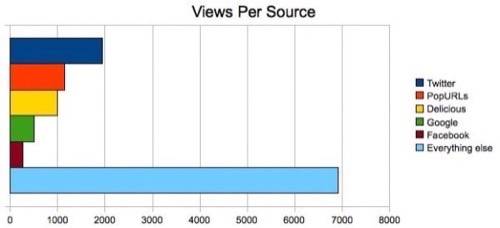One month ago Monica Rankin posted a video to YouTube about how she uses Twitter in her classroom at the University of Texas. Somehow this Monday morning the video showed up on the page of the most popular bookmarks for the day on Delicious. It had only been viewed 425 times and neither Rankin nor we could figure out how it got bookmarked so much in that one random day. It’s a very good video though, so we wrote a blog post about it that saw an unusually high 12,000 views within 24 hours. We decided to pay very close attention to where those readers came from, just to see what we could learn, and some unexpected trends emerged from the data.

We’ve posted below a series of charts showing how many people clicked through that article hour by hour and from where they came. It’s just one blog post, but this example sheds some light on a few interesting questions people are asking about the social web.
Is Twitter becoming a meaningful source of traffic? Is Delicious still one? How do times of day influence how people share things online? These questions and more can feel a touch less vexing with each snapshot we take; this is one of those snapshots.

Here’s how it went down. I was scanning RSS feeds Monday morning and discovered Rankin’s video in the feed for Delicious Popular. I assumed that one of our competitors had written about it already, but in looking around I couldn’t find anyone at all who had. I sat on it for hours, unfortunately writing another post about Twitter and one from a news tip I got via Twitter (is there anything else to write about these days?).
At 3 PM PST I wrote up the post about Rankin’s class. I embedded her video and added more examples of Twitter in classrooms and related resources discovered on Delicious. I visited delicious.com/tag/twitter+classroom, opened up several pages worth of recent bookmarks using the Autopagerize Greasemonkey Script, then sorted all the bookmarks visible by number of saves using the Delicious Sort Visible Links script. That made it easy to find high quality related links to include in the post.
The post could have been much better written than it was, but it did much, much better than I expected it to. It was also an exception to the rule gleaned from a much larger aggregate study we wrote about last year finding that 4 PM PST on a Monday is one of the worst times to put up a blog post if you want it to get social media traction.
At 4 PM I put up the post and Tweeted out the link. 500 people clicked through and read it in the first hour, mostly from Twitter but some from Google Reader.
Note that Twitter desktop clients, a thousand random URL shorteners and other factors lead to a major under-counting of actual traffic from Twitter. Imagine the Twitter line below bumped up but trends remaining the same.

Traffic slowed a bit, then the post made it to the bottom of Delicious Popular after three hours. From there it hit aggregator site PopURLs, the secret winner in all these numbers. Traffic stayed strong throughought the night (West Coast night, that is) except for a short dip at 3 AM. Then the East Coast of the US started waking up and people started sharing and bookmarking the post again.
The link moved from Delicious Popular to the much more popular outright front page of Delicious.com at 9 AM PST, leaving PopURLs in the dust for a few hours. A steady trickle of visitors kept coming in that morning from Facebook.
Suddenly, perhaps because it was lunch time (noon) on the West Coast and 3 PM near or at the end of school on the East Coast, a flood of people started coming in from Twitter and elsewhere. It was 20 hours after we wrote, published and Tweeted about the article ourselves. I sat down to lunch with an iPhone developer thinking the post had lived out its short-term life at several thousand views, only to come out of lunch to discover a huge spike in readers.
Twitter search and archives are such a mess that it’s probably impossible to reconstruct exactly what happened at noon, but it may have been that people got some free time, found the link on the front page of Delicious and then Twittered it out to friends. It’s also possible that Delicious and Twitter users are different but overlapping groups and there’s some other explanation for the Twitter spike. Google Reader click-throughs were at a day-long high at the same time.
As fast as the influx of traffic came, it was gone again. Within two hours all the sources of traffic had fallen back to their half-day lows, except for the slowly growing Facebook referrals.

Note the “other” category above includes small contributors like FriendFeed, JimmyR.com and OurSignal – but it also includes a whole lot of Twitter desktop clients and other hard-to-track sources.
A Few Take Aways
I’ve spent some time throughout the day looking at this data and have thought of the following:
Obviously PopURLs is not to be forgotten. It’s old school, not exclusively focused on tech but clearly remains a popular place to find content.
Twitter is clearly becoming a major traffic driver, though this was a post about Twitter. It’s very interesting that the spike in Twitter traffic came almost a full day after the first wave of Tweets about this article. Something else kicked it off, it’s hard to say what.
ReadWriteWeb should probably be developing a bigger presence on Facebook. It’s much bigger than all of these other sites but just barely made the chart for traffic. It stayed steady throughout the 24 hour period, though.
This wasn’t the kind of post that was going to do well on Digg or Hacker News but those aren’t the only games in town. I thought it might do well on StumbleUpon but it hasn’t yet.
There’s an interesting rhythm in that chart of traffic by sources, isn’t there? What other patterns of interest do you see?
You can find ReadWriteWeb on Twitter, as well as the entire RWW Team: Marshall Kirkpatrick, Bernard Lunn, Alex Iskold, Sarah Perez, Frederic Lardinois, Sean Ammirati, Doug ColemanDana Oshiro, Steven Walling and Lidija Davis.





















